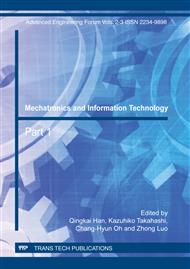[1]
J. Arata, H. Kondo, N. Ikedo and H. Fujimoto, Haptic device using a newly developed redundant parallel mechanism, IEEE Transactions on robotics, 27, 2 (2011) 201-214.
DOI: 10.1109/tro.2010.2098272
Google Scholar
[2]
F. Patanè and P. Cappa, A 3-DOF parallel robot with spherical motion for the rehabilitation and evaluation of balance performance, IEEE Transactions on neural systems and rehabilitation engineering, 19, 2 (2011) 157-166.
DOI: 10.1109/tnsre.2010.2089535
Google Scholar
[3]
C.M. Gosselin, S. Lemieux, J. -P. Merlet, A new architecture of planar three-degrees-of- freedom parallel manipulator, Proceedings of the IEEE International Conference on Robotics and Automation, Minneapolis, MN, April 22–28, 1996, p.3738–3743.
DOI: 10.1109/robot.1996.509283
Google Scholar
[4]
M. Hu, W. Wang; G. Cai, Development and study of a kind of parallel robot with 3-DOF, Proceedings of the 2008 Chinese Control and Decision Conference, pp.2887-90, 2 July (2008).
DOI: 10.1109/ccdc.2008.4597852
Google Scholar
[5]
K.H. Hunt, Structural kinematics of in-parallel-actuated robot arms, Mechanical Transmission and Automation Design, 105 (1983) 705–712.
DOI: 10.1115/1.3258540
Google Scholar
[6]
J.M. Hervé, Group mathematics and parallel link mechanisms, Proceedings of the International Symposium on Robotics, Mechatronics, and Manufacturing Systems, 1992, p.459–464.
Google Scholar
[7]
J. Luo, D. Wang, Y. Jiang, Geometry optimization of a new hybrid robot manipulator, submitted to the 2011 IEEE International Conference on Mechatronics and Automation.
DOI: 10.1109/icma.2011.5985706
Google Scholar
[8]
X. J. Liu and J. Wang, A new methodology for optimal kinematic design of parallel mechanisms, Mechanism and Machine Theory, 42 (2007) 1210–1224.
DOI: 10.1016/j.mechmachtheory.2006.08.002
Google Scholar
[9]
M. Stock and K. Miller, Optimal kinematic design of spatial parallel manipulators: application to linear Delta robot, Mechanical Design, 125 (2003) 292–301.
DOI: 10.1115/1.1563632
Google Scholar
[10]
X. Zhang, C. A. Nelson, Multiple-criteria kinematic optimization for the design of spherical serial mechanisms using genetic algorithms, Mechanical Design, 133(2011), 1-10.
DOI: 10.1115/1.4003138
Google Scholar
[11]
S. D. Stan,.V. Maties,R. Balan, C. Lapusan, Genetic algorithms to optimal design of a 3 DOF parallel robot, Proceedings of the 2008 IEEE International Conference on Automation, Quality and Testing, Robotics, pp.365-370, (2008).
DOI: 10.1109/aqtr.2008.4588856
Google Scholar
[12]
D. Wang, N. M. Kwok, D. K. Liu and Q. P. Ha, Ranked pareto particle swarm optimization for mobile robot motion planning, Design and Control of Intelligent Robotic Systems, Berlin Heidelberg: Springer-Verlag, 2009, pp.97-118.
DOI: 10.1007/978-3-540-89933-4_5
Google Scholar


